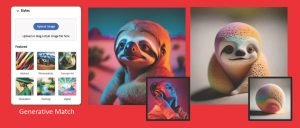Artificial Intelligence
Adobe Leading Future Design With New Generative AI Models

In a world where design and technology converge like never before, Adobe is leading the charge with its latest innovations. The tech giant recently announced the introduction of three new generative AI models, set to redefine the capabilities of Illustrator, Adobe Express, and Photoshop. These AI-driven enhancements promise to empower designers and creators to push the boundaries of their imagination.
The digital design realm is about to experience a seismic shift, thanks to Adobe's forward-thinking vision. At a recent company event, Adobe pulled the curtains back on its cutting-edge Firefly Image 2 model. This isn't just another iteration; it's a significant leap. But that's not all. Alongside this powerhouse, Adobe also presented two additional Firefly models specifically tailored for generating vector images and design templates, elevating the design process to new heights.
Elevating Imagery with Firefly Image 2
The Firefly Image 2 model is nothing short of a masterpiece. It's a testament to Adobe's commitment to enhancing image quality and providing tools that resonate with modern design needs. When pitted against its predecessor, the Firefly Image 2 model boasts of superior image generation. This is evident in the intricate details it captures, such as the intricate textures of human skin.
Moreover, the images rendered using this model are not just high-resolution but also radiate with vivid colors and striking color contrasts.
Beyond its image generation prowess, the model introduces groundbreaking AI-powered editing capabilities. Designers can now delve deep into their creative processes, manually or automatically adjusting parameters like depth of field, motion blur, and field of view — reminiscent of manual camera controls. To further assist users, Adobe has incorporated a “Prompt Guidance” feature. This intuitive addition aids in refining text descriptions and even offers auto-completion for prompts, streamlining the design workflow.
Embracing Brand Consistency with Generative Match
In today's dynamic digital landscape, brand consistency is paramount. Recognizing this, Adobe has introduced the “Generative Match” feature, a game-changer for brands looking to maintain a cohesive visual identity across various platforms. This innovative tool allows users to adjust the style of generated content to match specific images. Whether drawing from a preselected list or uploading their unique references, designers have unparalleled control over the final look of their creations.
The power of this feature doesn't stop there. Adobe has incorporated a slider that lets users determine the degree of resemblance between the reference and the generated image. This ensures that brands can strike the perfect balance between innovation and consistency.
Furthermore, in an age where transparency is valued, Adobe ensures that the origins of images aren't shrouded in mystery. Every piece of content generated using the Generative Match feature comes with “Content Credentials.” This not only builds trust but also ensures clarity in the ever-evolving realm of digital content.

Vector Design Reimagined: The Firefly Vector Model
Vector design, a cornerstone of digital art and graphic design, is poised for a revolutionary transformation. Enter the Firefly Vector model — Adobe's answer to the evolving needs of the design community. This state-of-the-art model doesn't just generate a singular image. Instead, it presents users with three distinct variations, empowering them to select the one that aligns best with their vision.
Safety and compliance are paramount in the commercial realm. Adobe addresses this head-on, ensuring that the Firefly Vector model is primed for commercial use. It is trained on licensed content, including offerings from Adobe Stock, as well as public domain content where copyrights have lapsed. This ensures that designers and brands can utilize the model with confidence.
For those eager to experience this innovation, Adobe has made the Firefly Vector model accessible via the Adobe Illustrator beta. Users can also explore other beta features, such as Mockup — a tool that realistically stages designs on 3D models — and Retype, which aids in identifying and editing vector fonts.

Revolutionizing Templates: The Firefly Design Model
In an era where efficiency and customization go hand in hand, Adobe's Firefly Design model emerges as a beacon of innovation. The Firefly Design model, with its astute AI capabilities, generates tailor-made templates for a myriad of applications — be it print, social media posts, online advertisements, videos, or more.
The genius of this model lies in its simplicity. Users need only provide text prompts, and the model gets to work, crafting fully editable templates that cater to popular aspect ratios. It's a paradigm shift from the traditional design process, where users had to piece together individual text and image assets on a blank canvas.
Furthermore, the AI-generated templates aren't just placeholders. They serve as personalized starting points, ensuring designers embark on their projects with a clear direction, rather than navigating the vast ocean of pre-existing designs.

Adobe's Bold Move in the AI Arena
As we reflect on Adobe's latest offerings, it's evident that the company is not just adapting to the AI era but pioneering it. The introduction of these generative models, though currently in beta, signals a bold step forward. Given the success of the original Firefly model, which has been instrumental in generating over 3 billion images, the potential of these new additions is boundless.
Yet, in the larger context, Adobe's move isn't just about staying ahead of the curve. It's a testament to their commitment to empowering designers, ensuring they have the tools and technologies to bring their visions to life in the most vivid and impactful ways.
In a landscape where numerous companies are venturing into AI-powered creative tools, Adobe's decision to unleash its AI innovations speaks volumes. It's not just about staying competitive; it's about redefining what's possible in the realm of digital design.
With these advancements, one thing is clear: The future of design is here, and Adobe is at the helm, guiding us toward uncharted territories of creativity and innovation.








